
Rosa banksiae, common names Lady Banks' rose, or just Banks' rose, is a species of flowering plant in the rose family, native to central and western China, in the provinces of Gansu, Guizhou, Henan, Hubei, Jiangsu, Sichuan and Yunnan, at altitudes of 500–2,200 m (1,640–7,218 ft). The rose is named for Dorothea Lady Banks, the wife of the botanist Sir Joseph Banks.
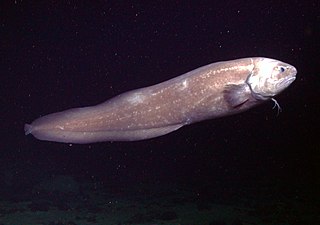
The cusk-eel family, Ophidiidae, is a group of marine bony fishes in the Ophidiiformes order. The scientific name is from the Greek ophis meaning "snake", and refers to their eel-like appearance. True eels diverged from other ray-finned fish during the Jurassic, while cusk-eels are part of the Percomorpha clade, along with tuna, perch, seahorses and others.

Spectrotrota is a monotypic genus of moths in the family Pyralidae. Its sole species, Spectrotrota fimbrialis, is found in Australia.

Sabatinca aurella is a species of moth of the family Micropterigidae. It is endemic to New Zealand. The larvae of this species are variable in appearance but tend to be coloured yellow-green with greyish patches. The adults of the species have a pale golden appearance with silver or purple coloured bars on the forewings. The moth has an approximate wingspan of around 1cm. This species is found from the Coromandel Peninsula to the Fox Glacier and is on the wing from September to January. A larval host species is the liverwort Heteroscyphus lingulatus. The preferred habitat of this species is at higher altitudes than other New Zealand endemic species in this genus; and the moth tends to prefer forest or subalpine grass or scrubland.
Fractolatirus normalis is a species of sea snail, a marine gastropod mollusk in the family Fasciolariidae, the spindle snails, the tulip snails and their allies.
Fractolatirus is a genus of sea snails, marine gastropod mollusks in the family Fasciolariidae, the spindle snails, the tulip snails and their allies.
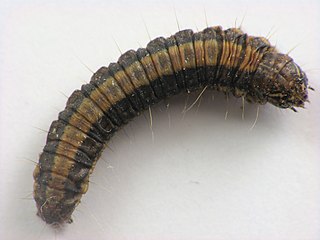
The Epipaschiinae are a subfamily of snout moths. More than 720 species are known today, which are found mainly in the tropics and subtropics. Some occur in temperate regions, but the subfamily is apparently completely absent from Europe, at least as native species. A few Epipaschiinae are crop pests that may occasionally become economically significant.
Araeopaschia is a genus of snout moths. It was described by George Hampson in 1906.

Aphyocypris is a genus of cyprinid fishes consisting of eight species, all of which are restricted to East Asia.
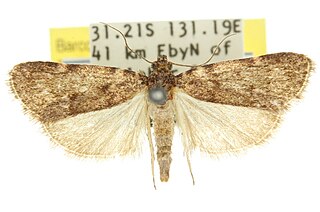
Araeopaschia demotis is a species of snout moth in the genus Araeopaschia. It was described by Edward Meyrick in 1887 and is known from Australia.
Araeopaschia rufescentalis is a species of snout moth in the genus Araeopaschia. It was described by George Hampson in 1906. It is found in Australia.
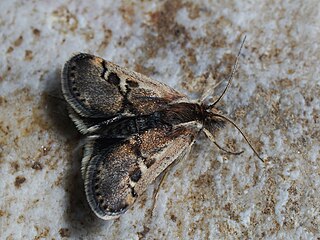
Titanio normalis is a species of moth in the family Crambidae. It is found in Spain, Italy, Austria, the Czech Republic, Slovakia, Hungary, Croatia, Romania, Bulgaria, the Republic of Macedonia, Greece, Belarus, Russia and Turkey.
Copelatus normalis is a species of diving beetle. It is part of the genus Copelatus in the subfamily Copelatinae of the family Dytiscidae. It was described by Wilhelm Ferdinand Erichson in 1847.

Euphaedra themis, the common Themis forester, is a butterfly in the family Nymphalidae. It is found in the Guinea, Sierra Leone, Liberia, Ivory Coast, Ghana, Togo, Benin, Nigeria and western Cameroon.
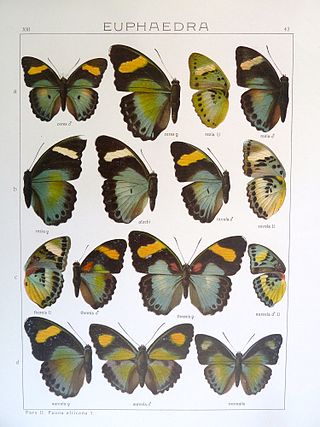
Euphaedra normalis is a butterfly in the family Nymphalidae. It is found in Sierra Leone.

Carex normalis, the greater straw sedge, is a species of sedge that was first described by Kenneth Mackenzie in 1919.
Epicauta normalis is a species of blister beetle in the family Meloidae. It is found in Central America and North America.
Eurygenium is an extinct genus of notoungulate belonging to the family Notohippidae. It lived during the Late Oligocene in what is today South America.
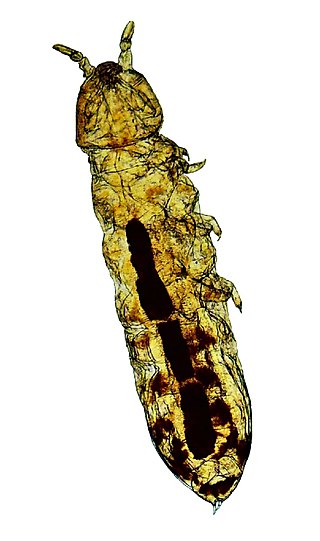
Bionychiurus is a genus of the family Onychiuridae, a group of springtails. Genus Bionychiurus was established by Pomoroski in the year 1996, based on the morphological features of the first instar larvae of Onychiurus normalis. Later, Weiner established a new genus Bangallophorus based on O. normalis; but Pomorski synonymized Bangallophorus with Bionychiurus in 1998.












